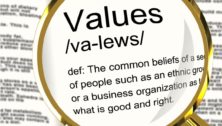Tuesday with Michael: The 5 Realms of Emotional Intelligence

In recent years emotional intelligence has become a topic of high interest in the business world and the industry and practice of personal leadership development. Current research has supported the theory that Emotional Intelligence can be quantified and measured and that it can also be improved and developed within an individual.
Exactly what does this mean for individuals and organizations?
First, we need to take a look at one model of Emotional Intelligence (EI). Last week, we discussed Goleman’s five domains of EI: Self Awareness, Social Awareness, Self-Management, and Relationship management. Two of these domains are self-competencies and the others are social competencies.
These domains are broken into five realms. Positive Psychology.com identifies the five realms of Daniel Goleman’s model as: know your emotions, manage your emotions, motivate yourself, recognize and understand other people’s emotions, and manage relationships (other’s emotions).
These competencies are critically important to be successful in life and business. The foundation for goal achievement is so intricately enmeshed with emotions that it is impossible to understand personal and organizational productivity without understanding EI.
EI tells us how we relate to ourselves and how we relate to each other and involves both recognition and regulation. The higher levels of EI that we have, the more capable we are in maintaining positive connections with ourselves and others.
When we are connected with ourselves, we are able to be in control of our emotions and our behaviors. When we are able to maintain control of ourselves, we can then help others regulate their own emotions and influence their behavior also.
Human beings have an innate need for relationships and personal connections. In everyday life, these connections contribute to our feelings of happiness and personal success if our EI is able to support healthy connections. When our EI is low, we have difficulty regulating our emotions and behavior and thus, we have difficulty forming and maintaining healthy relationships with others.
In business, the same is true. Employees and leaders with high emotional intelligence are more productive because they are able to regulate their emotions and motivate themselves. They develop positive relationships with others which improves their job satisfaction and also improves effectiveness in achieving their goals.
The quality of one’s relationships with coworkers, subordinates, supervisors, customers, and vendors is the primary determining factor for success in one’s career. Working on improving and developing EI contributes to increased quality of life both personally and professionally.
Research shows that successful leaders and superior performers have well-developed emotional intelligence skills. This makes it possible for them to work well with a wide variety of people and to respond effectively to the rapidly changing conditions in the business world. In fact, a person’s (EQ) emotional intelligence may be a better predictor of success performance than intelligence (IQ).
How can we improve our emotional intelligence? First, check out this FREE E-book from TTI Success Insights, Ten Ways to Increase Emotional Intelligence and then e-mail me: Michael@achievable.com to find out more about EI and how I can help you identify your own EI and the EI of the employees in your organization.
I can lead you through a program to increase your emotional intelligence and improve your personal leadership skills. These programs can also be tailored to small and large groups, so you can help your employees grow personally and professionally, right along with you.
Change can be scary but I know this change will be worth it for you. I know it has been for me.
Connect With Your Community
Subscribe to stay informed!
"*" indicates required fields



![95000-1023_ACJ_BannerAd[1]](https://vista.today/wp-content/uploads/2023/03/95000-1023_ACJ_BannerAd1.jpg)












































